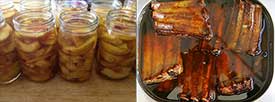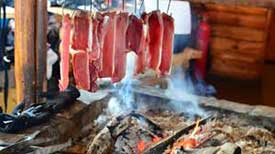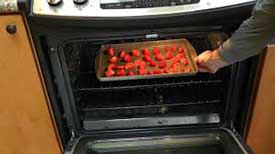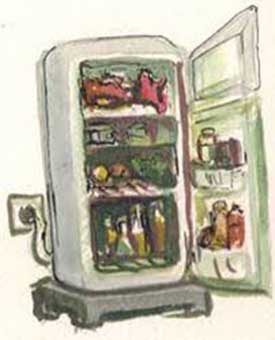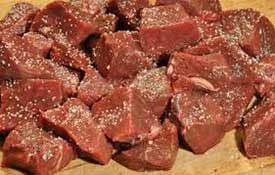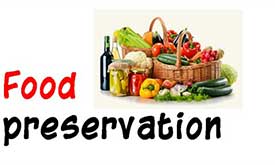Proper storage by
Jane James
6
Food preservation
Food preservation means keeping food in its fresh form to avoid contamination or to ensure that it does not go bad. We usually preserve food when it is in excess to ensure that we use it at a later date. Food can be preserved in various ways. Some ways may be traditional while other ways are modern.
Traditional ways of preserving food
Smoking is mainly used to preserve fish and meat. The meat to be preserved is hang high above a smoky fire until a hard outer layer is formed. This crust of smoke forms the barrier that prevents entry of micro-organism that cause spoilage. The layer or crust is also poisonous to the micro-organisms. In most cases, the meat or fish is dried before smoking. The fire to be used should be of low temperature.
1. Smoking
▶ Smoking is mainly used to preserve fish and meat. The meat to be preserved is hang high above a smoky fire until a hard outer layer is formed. This crust of smoke forms the barrier that prevents entry of micro-organism that cause spoilage. The layer or crust is also poisonous to the micro-organisms. In most cases, the meat or fish is dried before smoking. The fire to be used should be of low temperature.
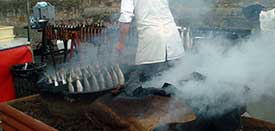
2. Drying
Examples of foods that can be preserved by drying are meat, fish, maize, beans and peas.The food is spread on animal skins or mats and left in the open air where it is exposed to

3. Salting
▶ The foods that can be preserved by salting are meat and fish. In this method the food is sprinkled with salt. Micro-organisms cannot grow in concentrated salt solutions. Salt also kills the micro-organisms by draining water from them (dehydrating them).
4. Use of honey
Food that can be preserved using honey ismeat. The food is first cooked or roasted andthen dipped into a container with honey. Thehoney should cover all the parts of the food.Honey contains a high concentration ofsugar. Most micro-organisms cannot grow orlive in concentrated sugar. The concentrated sugar dehydrates the micro-organisms
6
5. Proper storage Proper storage of food was essential even in the old days. Foods are always kept in cool dry places to prevent them from getting moist. Grains are kept in granaries that are cool and well ventilated. The granaries also protect the food from getting wet.
Modern methods of preserving
▶ Modern methods of food preservation are those methods that are being used today. The modern methods rely more on technology than the natural ways and natural products to preserve food. Modern technology has introduced the use of electricity and chemicals.
The modern methods of preserving food are:
▶ Drying
▶ Freezing
▶ Canning
▶ proper storage
▶ Salting.
▶ smoking
1. Smoking
▶ In modern smoking, the food (meat or fish) is cut into smaller pieces and then arranged on racks in specially built structures called smoke-houses. The food is then exposed to chemical treatment by coating the food with a layer of chemicals which are sprayed on to the food.
2. Drying
▶ The food may be air-dried or dried in an oven until it loses water. The heat in the oven kills the micro-organisms. Once the food is dry, micro-organisms cannot grow in it.
3. Use of low temperature
▶ Food such as meat, fruits, vegetables, milk and other drinks are preserved at low temperature in refrigerators, freezers or cold storage rooms. These use electricity to cool the food to very low temperatures.
4. Canning
▶ Canning means putting foods in cans or tins from which all air has been removed. The can or tin is then tightly sealed or closed. The can or tin therefore becomes air tight. The sealed can or tin is then heated in boiling water or steam at high temperature for a while

5. Proper storage
▶ The food storage facilities are cupboards, kitchen shelves, granaries, silos, vegetable racks and refrigerators.

6. Salting
▶ The modern method of salting involves soaking food in brine which is a concentrated solution of salt and water. Meat, fish and some vegetables are preserved in this way. The concentrated salt solution kills micro- organisms.
Reasons for preserving food
Why do we need to preserve food?
▶ To ensure that excess food is kept for future use so that the food is left in its natural state. Food spoils or rots if it is not well preserved. preserved food like meat or fish can be transported in its fresh state from the points of production to the markets. preservation reduces wastage.
Questions
- Why is it important to preserve food?
- What are some of the traditional methods of preserving food?
- Describe how saluting was used in traditional community to preserve food?
- What are the modern ways of preserving food?
Answers
Question 1:
To ensure that excess food is kept for future use so that the food is left in its naturalstate
Question 2:
Smoking
Drying
Salting
Question 3:
The foods that can be preserved by saltingare meat and fish.
In this method the food issprinkled with salt. Micro-organisms cannotgrow in concentrated salt solutions.
Salt also kills the micro-organisms by draining waterfrom them (dehydrating them).
Question 4:
Canning
Salting
Use of honey
Drying
Use of low temperatures



